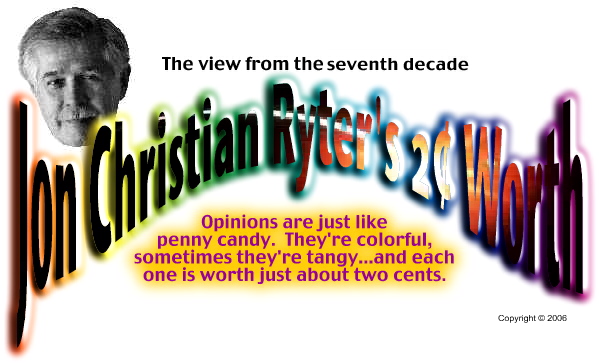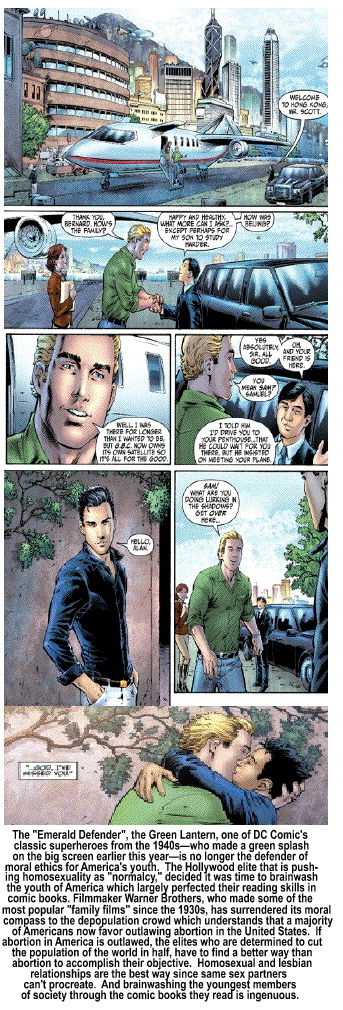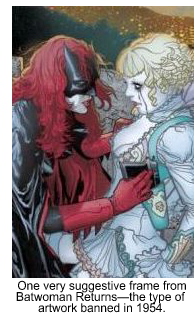
News
Behind the Headlines
Two-Cents Worth
Video of the Week
News Blurbs
Articles
Testimony
Bible Questions
Internet
Articles (2012)
Internet Articles (2011)
Internet Articles (2010)
Internet Articles
(2009)
Internet Articles (2008)
Internet Articles (2007)
Internet Articles (2006)
Internet Articles (2005)
Internet Articles (2004)
Internet Articles (2003)
Internet Articles (2002)
Internet Articles (2001)

DC Comics recasts a second super-hero as a
homosexual. After bringing Batwoman "out of
the closet," DC Comics, which is owned by Warner
 Brothers, reintro-
Brothers, reintro-
duced the original
Green Lantern, Alan
Scott as a homo-
sexual in the parallel-
world Earth-2. How
will this impact a
sequel to Warner's
2011 hit Green
Lantern movie?
n September, 1954 the Comics Magazine Association of America [CMAA] formed what it called the Comics Code Authority in response to widespread public concern over horrific storylines based on extreme violence. Ultimately it would deal with issues like the use of illegal drugs and, of course, homosexuality. The CMAA was formed because the voluntary rules drafted by the Association of Comic Book Publishers in 1948 that banned depictions of gory violence were simply unenforceable.
It was not until the city councils in Oklahoma City, OK and Houston, TX passed ordinances banning crime and horror comic books (after an attempt by Los Angeles to ban comic books was found to be unconstitutional), that the CMAA realized if it did not learn how police itself, someone else would do it for them.
Under the new 1954 code, the CCA prohibited any comic book publisher from making policemen, judges, government employees and members of respected institutions from appearing as villains, or in any way depicting them in a disrespectful manner, or showing disrespect for the established authority in the country.
On April 21, 22 and June 4, 1954 the US Senate Judiciary Committee held hearings on juvenile delinquency, which was specifically focused on comic books, determined that comic books were a bad influence on the minds of youth. To the comic book industry, the US government had just fired a shot over their bows. Government regulation, they surmised, would come next if they didn't do something like the newspaper industry when FDR tried to take control of the news media in the United States.
That "established authority" in 1954 realized that government officials had decided that comic books could be used to brainwash people—and declared war on what amounted to 1% of the "media" (the fantasy media) to prevent them from showing the next generation of voters just how corrupt the "established authority" in America really was. And, because that knowledge would have significance to them, the princes of industry would remember that. The comic book industry realized that it had to self-regulate—and they had to do it then.
They began by eliminating scripts that depicted seduction, rape, sadism and masochism. Hemlines dropped and cleavage was a "no-no." Love stories were enjoined to emphasize the sanctity of marriage, and storylines dealing with "lovemaking" were advised to avoid the baser emotions. Likewise, the depiction of excessive violence was forbidden, and instances of law enforcement officers dying as the result of criminal activity was discouraged. Specific restrictions (recommended by Senators ) on kidnapping and carrying concealed weapons were included in the new regulations and Congress made it clear they were concerned about comic books advocating carrying concealed weapons. The CMAA quietly deferred. Clearly, comic books can be used to brainwash the youth of America. When, pray tell, will the purveyors of population control within the United States government—who bow to the whims of the princes of industry and the barons of banking—who believe there are too many people in the world, resort to propagandizing comic books to serve their depopulation agenda? Hmm. I wonder. How about now?
Clearly, it was going to be just a matter of time before Senator Estes Kefauver [D-TN] who had just galvanized his reputation as a crime fighter by taking on organized crime, would be calling for the legislated regulation of free speech in comic books. Kefauver, a social progressive Roosevelt New Dealer, believed that the United States government had not only the right and the authority, but the absolute power, to exercise control over the people of the United States.
One of Kefauver's key witnesses was a psychiatrist named Frederic Wertham who claimed that comic books contained both covert and overt depictions of sex and violence that encouraged delinquency in children. Introduced as evidence was his book, "Seduction of the Innocent" which outlined his theories on the subliminal sexual themes interwoven throughout all of the super hero comic books. In it, he asserted. Wonder Woman was covertly depicted as a lesbian (based on her super strength and her independence from men). And, Wertham noted that Batman and Robin were homosexual lovers. Which is why, in 1956, Action Comics created Batwoman). She was to be Batman's girlfriend. Imagine Bruce Wayne's surprise 50 years later to discover Kathy Kane was a lesbian.
The Association of Comic Book Publishers hired New York Judge Charles F. Murphy, 44, one of the nation's leading experts on juvenile delinquency to head the Comic Magazine Association of America. His job was to structure the guidelines of the Comic Code Authority [CCA] which was loosely copied from the Hollywood movie production code.
It would not be long before the comic book publishers in the 1960s began to rebel against their own policing agency as competition between rival publishers, led by DC Comics (which, through progression was then owned by National Periodical Publications, but was publicly called DC Comics). Competition was tough with DC Comics fighting for market share against newcomers like Fox Comics, Fawcett Comics, and Marvel Comics which largely created the genre of the Super Heroes although Fawcett created Captain Marvel and Capt. Marvel, Jr. and Action Comics (which was a product of National Periodicals) created both Superman and Batman.
As the Marvel Comics super heroes eclipsed DC Comics in the 1970s, DC Comics began to write in darker themes to drive sales, causing its competition, particularly Marvel Comics, to do the same. Marvel included a drug use theme in The Amazing Spiderman in 1971, defying and pretty much crushing the comic book code. DC Comics responded with a drug-fueled storyline in Green Lantern (entitled Snowbirds Don't Fly, #85, 9/1971) in which Speedy, Green Arrow's sidekick became a heroin addict. CCA complained, and Uncle Sam remained mute. Big Brother was watching, thinking about the propaganda value of comic books.
To compete with Marvel Comics (owned by Walt Disney Company) and what was left of the comic book competition in the closing days of the 20th century, DC Comics flooded the country with new super heroes. To boost the street sales of collectibles, DC Comics killed off Superman and crippled Batman. Then Green Lantern—Warner Brothers' new big screen super hero—morphed into the super villain Parallax. (If you saw the 2011 movie version of Green Lantern you know the enemy of the universe was a villain-entity called Parallax that the Hal Jordon character, "Green Lantern," kills off. And, of course if you saw the flick, you know Hal Jordan [played by nobody Ryan Reynolds] has a heterosexual relationship with a woman).
The 1990s brought a new comic genre—imprints for mature audiences. Sodom and Gormorrah was only a few penstrokes away. Clearly cartoon porn is as old as comic books themselves, but smut art never achieved the broad audience as comic books for mature audiences. Nor does smut art have the collectible value of comic books. On Feb. 22, 2010 a copy of the first Action Comics (#1, June, 1938) was purchased by an anonymous buyer for $1 million—the largest amount ever paid for a comic book. Previously, in 2009, a DC comic book sold for $317 thousand, then the record amount paid for a comic book.
DC Comics flooded the market with new super heroes in the late 1980s, wiping out much of its competition. However, in doing so, they killed many of their own loyal readers. The marketing scheme was called the "DC Explosion." But the decision to kill off, cripple or villainize super heroes, while providing a temporary boost in sales, caused what then became known as the "DC Implosion." In killing off their competition, DC Comics and Marvel killed off much their own customer base. Comic books had evolved into a specialty market product where diehard comic book fans were forced to go to specialty stores for much smaller circulated, much higher priced products. The world of comic books had finally gone from the mainstream to the dark side.
 Very
few Americans knew that Batwoman came "out of the closet"
in 2006 since less than 1% of the nation's population reads comic books
today. She was created as Batman's girl friend in 1956. But the
comic book world simply wasn't ready for a super-heroine other than Wonder
Woman, and DC Comics pulled the plug on her in 1979. When she
was reincarnated, Batwoman—or Kathy Kane, a rich socialite—returned
in early 2006 as a lesbian who was having a relationship with ex-police
detective Renee Montoya. Why would DC Comics dig up the corpse
of Batwoman after burying her for 33 years? And, why would they make
her a lesbian? (The gay and lesbian population in the United States is
estimated to be somewhere between 1% and 2%, and not the 10% to 20% estimated
by Dr. Alfred Kinsey in the largely exaggerated statistics in his
book Sexual Behavior in the Human Male [1948], commonly referred
to as The Kinsey Report). (The exaggerations in Kinsey's
work are based on his personal bias to prove his case (Kinsey was
a homosexual); and as it was revealed some yeas later—Kinsey's
"random selection of subjects" was not random. Kinsey's
subjects were male prison inmates and active male prostitutes. They were
not respondents to a blind, random sampling.)
Very
few Americans knew that Batwoman came "out of the closet"
in 2006 since less than 1% of the nation's population reads comic books
today. She was created as Batman's girl friend in 1956. But the
comic book world simply wasn't ready for a super-heroine other than Wonder
Woman, and DC Comics pulled the plug on her in 1979. When she
was reincarnated, Batwoman—or Kathy Kane, a rich socialite—returned
in early 2006 as a lesbian who was having a relationship with ex-police
detective Renee Montoya. Why would DC Comics dig up the corpse
of Batwoman after burying her for 33 years? And, why would they make
her a lesbian? (The gay and lesbian population in the United States is
estimated to be somewhere between 1% and 2%, and not the 10% to 20% estimated
by Dr. Alfred Kinsey in the largely exaggerated statistics in his
book Sexual Behavior in the Human Male [1948], commonly referred
to as The Kinsey Report). (The exaggerations in Kinsey's
work are based on his personal bias to prove his case (Kinsey was
a homosexual); and as it was revealed some yeas later—Kinsey's
"random selection of subjects" was not random. Kinsey's
subjects were male prison inmates and active male prostitutes. They were
not respondents to a blind, random sampling.)
It's not like DC Comics was going to sell any great volume of Batwoman Returns in September, 2006 (since the total comic book reading population in the country is somewhere around 6 million—out of 330 million people. And since only about 1% of them are likely homosexual, if every homosexual in the country bought that issue of DC Comics, only about 60 thousand copies would have been sold. If it wasn't for comic book sales, why then?
Because on June 6, 2006 the Republican-controlled House and Senate voted to enact The Defense of Marriage Act (DOMA), making marriage—by federal law—a union between one man and one woman. DOMA was passed and sent to the White House where President George W. Bush signed it into law. The population-reduction advocates who not only needed to repeal DOMA but enact a gender-neutral marriage law that legalized same sex marriage nationwide—with all of the protection of the federal courts, knew this could be a decade-long, if not longer, battle. During that battle, the population-reduction crowd knew they needed to win over advocates who believed there is no difference between a marriage between a man and a man, a woman and a woman, or a man and a woman except the same sex couples can't procreate the same way as the heterosexual couple.
Although National Public Radio announced it on June 1, 2006, only a few people knew about the Batwoman and Renee Montoya lesbian liaison. It wasn't until DC Comics converted their June, 2006 issue, Batwoman Returns, to a digital format last November that the cybermedia finally reported the story. But the only people who were excited about it was the Lesbian, Gay, Bisexual and Transgender community [LGBT]—and of course, the princes of industry who are anti-people and want population control either through abortion or couples who lack the ability to procreate the species.
On May 20, 2012 when DC Comics co-publisher Dan DiDio hinted that a new super hero was going to come out of the closet very soon, adding that any additional gay characters would be male. "One of the things we're very focused on doing for these types of [LGBT-inclusive] stories," DiDio said, "is, rather than change an existing character, we want to make sure that this is the basis of who that character is right from the start."
Of course, they didn't do that. On June 1 DC Comics announced that in the upcoming issue of "Earth 2", #2, the original Green Lantern, Alan Scott (not the current Green Lantern, Hal Jordan (who likes women) will be coming out of the closet. Alan Scott, if you remember was snuffed out because he became the arch villain, Parallax, that the Hal Jordan Green Lantern destroys in the Warner Brothers movie, Green Hornet. I guess in the fantasy world, or rather, parallel worlds, you can have as many Green Hornets as you like at the same time, so when you offend a reader or viewer, you can deny culpability by simply saying, "Oh, no, he's not that one. That one is Alan Scott. He lives in a parallel universe somewhere else. You can still spend your money on the heterosexual Green Lantern in the movie version."
Warner Brothers should be very aware that [a] no major studio wanted to play Russian Roulette by releasing the Heath Ledger film, Brokeback Mountain. Further, while social progressive filmmakers in Sodom on the Pacific and Gomorrah of Hollywood talk about the film's financial success in "art film houses," it cost $19 million to produce and promote, and took in $547 thousand on its first weekend. The film broke-even during its first 30 days only because River Road Entertainment managed to sell the foreign film rights. The producers pushed the film for 133 days and claim it earned $178 million worldwide. To achieve those numbers, the movie was literally shown in every country in the world except the Muslim world where homosexuality is a capital offense.
No matter how you spin it, a Green Lantern movie sequel in the United States with a homosexual super-hero is a box office kiss-of-death. But, here's the thing about arrogant social progressive anti-population, Hollywood movie moguls—depopulating the world for Al Gore, who is increasing finding it hard to even say "global warming" with a straight face, won't be that easy since real people see their super-heros as real people. If they were homosexual yesterday, they're just as homosexual today. And just as the watermelon heterosexuals who wanted to prove, through the box office, that traditional heterosexuals would flock to the movie theaters to watch two cowboys in a sexual embrace, roll around on the ground in a saddle blanket and not even get on cactus burr in the butt, they didn't convince any of us since none of us wasted our money on a barf flick.
So why did the far left pick this time to introduce a second homosexual super-hero? Because the Obama Justice Department and the Obama White House are refusing to defend the Defense of Marriage Act which is coming up before the US Supreme very soon. And, because Obama has promised the homosexual community the support of the White House and his pervert friends in Hollywood when Obama is reelected, they will vacate DOMA in the courts and legalize same-sex marriage. Well, for whatever it's worth, once again, you have my two cents worth on this subject. Until next time...



Copyright © 2009 Jon Christian Ryter.
All rights reserved.


